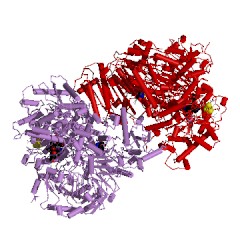| Synonyms |
EC 2.6.1.53, EhNO1, EhNO2, gltA, gltB, GltB1, GltB2, gltD, GltS, glutamate synthetase (NADP), glutamine amide-2-oxoglutarate aminotransferase (oxidoreductase, NADP), glutamine-ketoglutaric aminotransferase, GOGAT, L-glutamate synthase, L-glutamate synthetase, L-glutamine:2-oxoglutarate aminotransferase, NADPH oxidizing, NADPH-dependent glutamate synthase, NADPH-GltS, NADPH-glutamate synthase, NADPH-GOGAT, NADPH-linked glutamate synthase, pGLTY1, pGLTY2, pGLTZ, PH0876, PH1873, synthase, glutamate (reduced nicotinamide adenine dinucleotide phosphate) |
| Comments |
Binds FMN, FAD, 2 [4Fe-4S] clusters and 1 [3Fe-4S] cluster. The reaction takes place in the opposite direction. The protein is composed of two subunits, ¦Á and ¦Â. The ¦Á subunit is composed of two domains, one hydrolysing L-glutamine to NH3 and L-glutamate (cf. EC 3.5.1.2, glutaminase), the other combining the produced NH3 with 2-oxoglutarate to produce a second molecule of L-glutamate (cf. EC 1.4.1.4, glutamate dehydrogenase [NADP+]). The ¦Â subunit transfers electrons from the cosubstrate. The NH3 is channeled through a 31 ? channel in the active protein. In the absence of the ¦Â subunit, coupling between the two domains of the ¦Á subunit is compromised and some ammonium can be produced. In the intact ¦Á¦Â complex, ammonia production only takes place as part of the overall reaction. |


